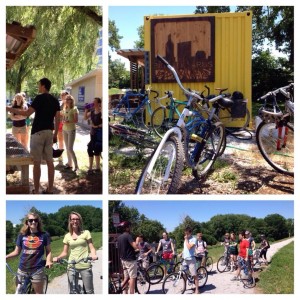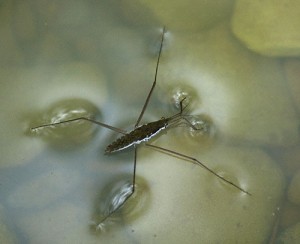by Tim Carter
 Each summer, one of the first activities we do with all of the CUE interns is to take a bike ride from Butler to downtown Indianapolis and back to campus. What always amazes me is that even though it’s one ride, we encounter five distinct biking experiences.
Each summer, one of the first activities we do with all of the CUE interns is to take a bike ride from Butler to downtown Indianapolis and back to campus. What always amazes me is that even though it’s one ride, we encounter five distinct biking experiences.
Section 1: The Central Canal Towpath
The crushed limestone surface along the towpath reflects the character of the “natural” surroundings as you move south from Butler past the Indianapolis Museum of Art and through neighborhoods down to 30th Street. It’s like a glorified mountain trail without the mountains…clearly there is care taken to maintain it, but there are some potholes (“Hole!!” we yell back to the 13 riders with us that day) and elements of risk (don’t stare to long at the turtles or you’ll find yourself down a steep slope). This year we noted how the bridges across the canal stop after the IMA. Why is that? Why aren’t those neighborhoods connected like all the northern ones?
Section 2: The White River Trail
We transfer over to the White River trail at the south end of the towpath. The transition at 30th Street has been greatly improved since our first ride three years ago. At the Naval Armory, we now have our own isolated path that weaves up to the crossing. It’s not quite complete, but prior to this you risked your life to make this crossing.
Once you are south of the interchange it’s pretty smooth sailing until 16th street. The character of the White River trail feels like the embodiment of the post-industrial, Midwestern city. Kind of tired, a bit neglected, lots of space and potential, but with emerging signs of life (e.g., Stadium Loft apartments are the highlight). This stretch ends with a dramatic entrance into the core of the city as you cross Fall Creek, encounter the shiny new Eskenazi Health complex, and roll into White River State Park.
Section 3: The Cultural Trail
So much has already been written about the Cultural Trail and it’s all true – it’s an iconic, important and significant piece of Indy’s infrastructure. It functions very differently than the first two sections of our ride. This isn’t a transportation corridor; it’s a sense-fest with lot to see, smell, and hear. You’re in the heart of the city and you can feel its pulse. At every stop, there is a new feature to point out…there’s one of the rain gardens, here’s the electric car share station, here’s the Pacers bikeshare, that’s where the new transit center is going. The Cultural Trail connects in a way totally distinct from any other riding experience.
***intersession*** We lunch at City Market and take a quick tour of Big City Farms as a great example of how urban space can be shared efficiently. Surplus parking lot space = vegetable growing.
Section 4: The Monon Trail
We’re now headed home and the return loop has us on the north-south interstate of Indy bike paths, the Monon Trail. The Monon has the well-worn feel of your favorite pair of shoes. It’s comfortable, operating simply but effectively, and getting better use with age. We stop at the north crossing of Fall Creek and visualize how sweet it will be when the new section of Fall Creek trail connects with the southwest crossing we made during Section 2.
Section 5: City streets
If all riding were like this, we wouldn’t do the ride. Negotiating with cars, upsetting commuters, hitting stoplights. The contrast between this experience and the other sections couldn’t be greater. We’re operating in a foreign land and we’re not wanted. Our saving grace is the critical mass that we collectively form that makes us impossible to ignore. The width of 46th Street west of Meridian Street provides a welcome respite completing the loop back to Butler.
As we’ve written about before, experiencing the city on bike is a process of rediscovery. If you haven’t done it, do it. You’ll find that the place where you live is filled with special spots you’re overlooking every day.
Tim Carter is director of the Center for Urban Ecology at Butler University.

